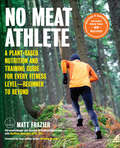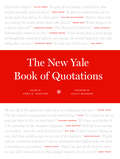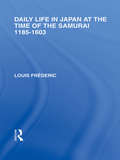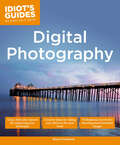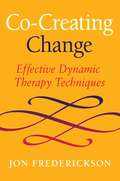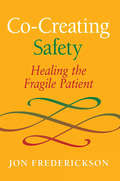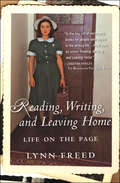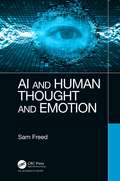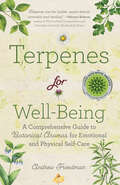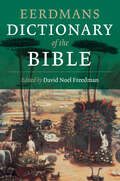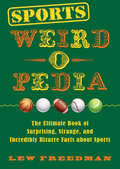- Table View
- List View
The New Natural Cat: A Guide for Finicky Owners
by Anitra Frazier Norma EckroateHow to take care of your cat the natural way. Contains instructions for feeding a natural diet, herbal preparations you can make for your cat, etc.
No Meat Athlete: A Plant-Based Nutrition and Training Guide for Every Fitness Level—Beginner to Beyond
by Matt Frazier Matthew RuscignoA vegan ultramarathoner “provides the roadmap to wellness and performance no matter where the journey takes you” (Scott Jurek, world-renowned Ultramarathon champion and New York Times–bestselling author).Veganism is taking off in the sports world. The lifestyle has been adopted by Olympians, body builders, and boxers, as well as top athletes in the NBA and NFL. Hollywood is on board, too. James Cameron (director of Avatar and Titanic) has produced a film on the topic called The Gamechangers, which follows vegan athletes, including Arnold Schwarzenegger, US Olympian Kendrick James Farris, and surfer Tia Blanco. In No Meat Athlete, author, blogger, and hundred-mile ultramarathoner Matt Frazier will show you the many benefits to embracing a plant-based athletic lifestyle, including: ·Weight loss, which often leads to increased speed ·Easier digestion and faster recovery after workouts ·Improved energy levels to help not only athletic performance, but your daily life ·Reduced impact on the planet In this revised and updated edition, you’ll also find new recipes, advice, and an all-new twelve-week strength training plan designed to improve your overall fitness. Section I of the book provides practical advice for transitioning to a plant-based lifestyle, while ensuring you are getting all the nutrition you need. In Section II, Matt delivers training manuals of his own design for runners of all ability levels and ambitions, including tips for creating healthy habits, improving performance, and avoiding injuries. No Meat Athlete is your road map to top-notch performance, the plant-based way!“Matt Frazier presents the tools and information . . . in a way that is downright approachable, leaving his readers energized with a sense of possibility.” —Brendan Brazier, Ultramarathon champion, professional Ironman triathlete, and author of Thrive
The New Yale Book of Quotations
by Fred R. Shapiro and Louis MenandA revised, enlarged, and updated edition of this authoritative and entertaining reference book —named the #2 essential home library reference book by the Wall Street Journal&“Shapiro does original research, earning [this] volume a place on the quotation shelf next to Bartlett's and Oxford's.&”—William Safire, New York Times Magazine (on the original edition) &“A quotations book with footnotes that are as fascinating to read as the quotes themselves.&”—Arthur Spiegelman, Washington Post Book World (on the original edition) Updated to include more than a thousand new quotations, this reader-friendly volume contains over twelve thousand famous quotations, arranged alphabetically by author and sourced from literature, history, popular culture, sports, digital culture, science, politics, law, the social sciences, and all other aspects of human activity. Contemporaries added to this edition include Beyoncé, Sandra Cisneros, James Comey, Drake, Louise Glück, LeBron James, Brett Kavanaugh, Lady Gaga, Lin-Manuel Miranda, Barack Obama, John Oliver, Nancy Pelosi, Vladimir Putin, Bernie Sanders, Donald Trump, and David Foster Wallace. The volume also reflects path-breaking recent research resulting in the updating of quotations from the first edition with more accurate wording or attribution. It has also incorporated noncontemporary quotations that have become relevant to the present day. In addition, The New Yale Book of Quotations reveals the striking fact that women originated many familiar quotations, yet their roles have been forgotten and their verbal inventions have often been credited to prominent men instead. This book&’s quotations, annotations, extensive cross-references, and large keyword index will satisfy both the reader who seeks specific information and the curious browser who appreciates an amble through entertaining pages.
Daily Life in Japan: At The Time of the Samurai, 1185-1603 (Routledge Library Editions: Japan)
by Louis FredericFrom the tenth century onwards the emperors of Japan gradually lost power. The local lords or clan chiefs waged ceaseless war against each other, while the court, wholly steeped in Chinese culture, seemed to take no further interest in the affairs of the nation. In 1191 the Minamoto clan mastered the disturbances and finally imposed its rule. Hard work, respect for the hierarchy, the cult of nationalism, a sense of self-sacrifice and duty – such was the new trend. The Buddhist doctrine of Zen made its appearance. It gave mystical support to the samurai, and the Japanese spirit was henceforth directed towards a political and religious asceticism which had an enormous influence on all aspects of art, thought and daily life. An acknowledged authority on the ‘classical’ period of Japanese history, the author reveals what the life of the Japanese people was like during these five centuries, and shows how a transformation of heart and mind produced a civilization as original as it was profound.
101 Things I Learned in Architecture School
by Matthew FrederickConcise lessons in design, drawing, the creative process, and presentation, from the basics of “How to Draw a Line” to the complexities of color theory.This is a book that students of architecture will want to keep in the studio and in their backpacks. It is also a book they may want to keep out of view of their professors, for it expresses in clear and simple language things that tend to be murky and abstruse in the classroom. These 101 concise lessons in design, drawing, the creative process, and presentation—from the basics of "How to Draw a Line" to the complexities of color theory—provide a much-needed primer in architectural literacy, making concrete what too often is left nebulous or open-ended in the architecture curriculum. Each lesson utilizes a two-page format, with a brief explanation and an illustration that can range from diagrammatic to whimsical. The lesson on "How to Draw a Line" is illustrated by examples of good and bad lines; a lesson on the dangers of awkward floor level changes shows the television actor Dick Van Dyke in the midst of a pratfall; a discussion of the proportional differences between traditional and modern buildings features a drawing of a building split neatly in half between the two. Written by an architect and instructor who remembers well the fog of his own student days, 101 Things I Learned in Architecture School provides valuable guideposts for navigating the design studio and other classes in the architecture curriculum. Architecture graduates—from young designers to experienced practitioners—will turn to the book as well, for inspiration and a guide back to basics when solving a complex design problem.
101 Things I Learned® in Advertising School (101 Things I Learned)
by Matthew Frederick Tracy ArringtonProviding unique, accessible lessons on advertising, this title in the bestselling 101 Things I Learned® series is a perfect resource for students, recent graduates, general readers, and even seasoned professionals. The advertising industry is fast paced and confusing, and so is advertising school. This installment in the 101 Things I Learned® series is for the student lost in a sea of jargon, data, and creative dead-ends. One hundred and one illustrated lessons offer thoughtful, entertaining insights into consumer psychology, media, audience targeting, creativity, and design, illuminating a range of provocative questions: Why is half of advertising bound to fail? Why should a mug in an ad be displayed with its handle to the right? How did the ban on cigarette advertising create more smokers? Why do people fall for propaganda? When doesn’t sex sell? Written by an experienced advertising executive and instructor, 101 Things I Learned® in Advertising School is sure to appeal to students, to seasoned professionals seeking new ways to craft an ad campaign, and to small-business owners looking to increase awareness of their brand.
101 Things I Learned™ in Fashion School
by Matthew Frederick Alfredo CabreraThe world of the fashionista is brought to vivid life with 101 introductory lessons on such topics as how a designer anticipates cultural trends and "sees" the fashion consumer, the workings of the fashion calendar, the ways a designer collection is conceived, the manufacture of fabric, fashion illustration, and more. Illustrated in the distinctly unique packaged style of the bestselling101 THINGS I LEARNED IN ARCHITECTURE SCHOOL, this new book on fashion design will be a perfect book for any fashion school wannabe, a recent graduate, or even a seasoned professional.
101 Things I Learned™ in Culinary School
by Matthew Frederick Louis EguarasLouis Eguaras, a renowned chef at the Le Cordon Bleu Program at the California School of Culinary Arts, provides readers with a terrific overview of what is truly involved in the preparation, cooking, and presentation of meals. He also provides invaluable insights into just what is involved in making this one's chosen profession. The book will feature a wide range of illustrated lessons, from how to properly hold a knife. . . to the history of food. . . from food preparation and presentation. . . to restaurant hospitality and management, and much more. The book will be presented in the distinctive and highly-attractive packaged style of 101 THINGS I LEARNED IN ARCHITECTURE SCHOOL, and will be the perfect gift for anyone who is thinking about entering culinary school, is already enrolled, or even just the casual chef.
101 Things I Learned® in Culinary School (101 Things I Learned)
by Matthew Frederick Louis EguarasAn informative, illustrated guide to food, cooking, and the culinary profession by a former White House chef—now in a revised second edition featuring 50% new material &“This book is all meat with no fat. . . . Sure to surprise and enlighten even the most informed gourmands.&”—Publishers Weekly (starred review), on the first edition of 101 Things I Learned in Culinary School A chef must master countless techniques, memorize a mountain of information, and maintain a Zen master&’s calm. This book illuminates the path to becoming a culinary professional by sharing important kitchen fundamentals and indispensable advice, including • practical how-tos, from holding a knife to calibrating a thermometer to creating a compost pile• ways to emphasize, accent, deepen, and counterpoint flavors• why we prefer a crisp outside and tender inside in most foods• understanding wine labels and beer basics• how to narrow innumerable culinary options to a manageable few, whether selecting knives, oils, thickeners, flours, potatoes, rice, or salad greens• how a professional kitchen is organized and managed to maintain its mission Written by a culinary professor and former White House chef, 101 Things I Learned in Culinary School is a concise, highly readable resource for culinary students, home chefs, casual foodies, and anyone else trying to find their way around—or simply into—the kitchen.
101 Things I Learned® in Product Design School (101 Things I Learned)
by Matthew Frederick Sung Jang Martin ThalerAn engaging, enlightening, and cleverly illustrated guide to product design, written by experienced professional designers and instructors. Products are in every area of our lives, but just what product designers do and how they think is a mystery to most. Product design is not art, engineering, or craft, even as it calls for skills and understandings in each of these areas—along with psychology, history, cultural anthropology, physics, ergonomics, materials technology, marketing, and manufacturing. This accessible guide provides an entry point into this vast field through 101 brief, illustrated lessons exploring such areas as • why all design is performed in relation to the body • why every product is part of a system • the difference between being clever and being gimmicky • why notions of beauty are universal across cultures • how to use both storytelling and argument to effectively persuade Written by three experienced design instructors and professionals, 101 Things I Learned® in Product Design School provides concise, thoughtful touch points for beginning design students, experienced professionals, and anyone else wishing to better understand this complex field that shapes our lives every day.
101 Things I Learned® in Engineering School (101 Things I Learned)
by Matthew Frederick John KuprenasProviding unique, accessible lessons on engineering, this title in the bestselling 101 Things I Learned® series is a perfect resource for students, recent graduates, general readers, and even seasoned professionals. An experienced civil engineer presents the physics and fundamentals underlying the many fields of engineering. Far from a dry, nuts-and-bolts exposition, 101 Things I Learned® in Engineering School uses real-world examples to show how the engineer's way of thinking can illuminate questions from the simple to the profound: Why shouldn't soldiers march across a bridge? Why do buildings want to float and cars want to fly? What is the difference between thinking systemically and thinking systematically? This informative resource will appeal to students, general readers, and even experienced engineers, who will discover within many provocative insights into familiar principles.
101 Things I Learned™ in Film School
by Matthew Frederick Neil LandauHow to set a scene? What's the best camera angle? How does the new technology interact with scenes? And how does one even get the financing to make a movie? These basic questions and much more are all covered in this exquisite packaged book on the film industry and making movies as a profession. Written by Neil Landau, an experienced screenwriter and script consultant to the major movie studios, this is the perfect book for anyone who wants to know about the inner-workings of this industry. Whether it's someone who wants to make movies as a full-timecareer, or just someone who is interested in film, this book covers it all.
101 Things I Learned® in Film School (101 Things I Learned)
by Matthew Frederick Neil LandauAn illustrated, accessible introduction to filmmaking from an award-winning Hollywood producer, screenwriter, film school professor, and script consultant to major movie studiosAnyone with a cellphone can shoot video, but creating a memorable feature-length film requires knowledge and mastery of a wide range of skills, including screenwriting, storytelling, directing, visual composition, and production logistics. This book points the aspiring filmmaker down this complex learning path with such critical lessons as:• how to structure a story and pitch it to a studio• ways to reveal a story&’s unseen aspects, such as backstory and character psychology• the difference between plot, story, and theme• why some films drag in Act 2, and what to do about it• how to visually compose a frame to best tell a story• how to manage finances, schedules, and the practical demands of productionWritten by an award-winning producer, screenwriter, film school professor, and script consultant to major movie studios, 101 Things I Learned® in Film School is an indispensable resource for students, screenwriters, filmmakers, animators, and anyone else interested in the moviemaking profession.
101 Things I Learned® in Urban Design School (101 Things I Learned)
by Matthew Frederick Vikas MehtaProviding unique, accessible lessons on urban design, this title in the bestselling 101 Things I Learned® series is a perfect resource for students, recent graduates, general readers, and even seasoned professionals. Students of urban design often find themselves lost between books that are either highly academic or overly formulaic, leaving them with few tangible tools to use in their design projects. 101 Things I Learned® in Urban Design School fills this void with provocative, practical lessons on urban space, street types, pedestrian experience, managing the design process, the psychological, social, cultural, and economic ramifications of physical design decisions, and more. Written by two experienced practitioners and instructors, this informative book will appeal not only to students, but to seasoned professionals, planners, city administrators, and ordinary citizens who wish to better understand their built world.
101 Things I Learned® in Law School (101 Things I Learned)
by Matthew Frederick Vibeke Norgaard MartinA provocative, accessible, and cleverly illustrated guide to legal principles and practice, by a law instructor and internationally experienced attorneyThis might be the most useful book law students ever read. Not because it contains the details of case law, but because it teaches them how to think like a lawyer. From the fundamentals of effective argument to the principles, structures, and assumptions underlying our legal system, 101 Things I Learned in Law School makes the impenetrable clear and the complex understandable. Illustrated lessons summarize landmark cases and illuminate a fascinating range of questions, including: * What is the difference between honesty and truthfulness? * Why is circumstantial evidence often better than direct evidence? * How does one find the proper sources to substantiate a legal argument? * Why do states deliberately pass unconstitutional laws? * How can testimony from a hostile witness be helpful?Written by an internationally experienced attorney and law instructor, 101 Things I Learned in Law School is a concise, highly readable resource for law students, graduates, professionals, and anyone else fascinated--or confused--by our legal system.
101 Things I Learned™ in Business School
by Matthew Frederick Michael W. Preis101 THINGS I LEARNED IN BUSINESS SCHOOL will cover a wide range of lessons that are basic enough for the novice business student as well as inspiring to the experienced practitioner. The unique packaging of this book will attract people of all ages who have always wondered whether business school would be a smart career choice for them. Judging by the growing number of people taking the GMATs (the entrance exam for business school) each year, clearly more people than ever are thinking about heading in this direction. Subjects include accounting, finance, marketing, management, leadership, human relations, and much more - in short, everything one would expect to encounter in business school. Illustrated in the same fun, gift book format as 101 THINGS I LEARNED IN ARCHITECTURE SCHOOL, this will be the perfect gift for a recent college or high school grad, or even for someone already well-versed in the business world.
101 Things I Learned® in Business School (101 Things I Learned)
by Matthew Frederick Michael W. PreisAn informatively illustrated guide to business principles by a professor, entrepreneur, consultant, executive, and Harvard Business School graduate.Success in business—and in business school—calls for a broad knowledge base and the ability to turn it into action. This accessible book provides a thorough grounding in the principles most essential to the study and practice of business, from corporate organization to maintaining customer satisfaction. Lessons include:• key elements of organizational philosophy, structure, culture, and behavior• ways to grow a business in new and existing markets• why fast-growing companies may be chronically short on cash• how to manage and interpret data when weighing a decision• how to run a meeting most effectively• how social and environmental responsibility can be good for business101 Things I Learned® in Business School will appeal to students seeking traction in a demanding curriculum, to self-made entrepreneurs looking to improve their business practices, and to seasoned professionals seeking a refresher on core principles.
Digital Photography: Expert Secrets for Shooting More Professional Images (Idiot's Guides)
by Shawn FrederickIdiot's Guides®: Digital Photography is the simplest guide to becoming a better photographer and taking better pictures with any basic digital camera or DSLR. Instead of focusing on complicated and quickly outdated topics like gear or retouching software, you'll learn the timeless principles of good photography, the essentials of every camera and lens, and how to use all that knowledge to take the pictures you previously thought were only achievable by professional photographers. You'll learn how to set up every shot, avoid common mistakes, and do more with your pictures through unique and creative digital photography projects. Focused on making people better photographers, this easy-to-understand, full-color guide finally simplifies the process of taking great pictures by focusing on what people really need to know.
Co-Creating Change: Effective Dynamic Therapy Techniques
by Jon FredericksonDo you have patients who are "stuck" and resist change? Would you like to help the 50 percent of patients who drop out of therapy before they have received its full benefits?To be successful therapists must know how to intervene to help patients experience previously avoided feelings. Co-Creating Change provides clear systematic steps for assessing patients' needs and intervening. Every technique is illustrated with a clinical vignette. The vignettes--representing hundreds of therapeutic impasses taken from actual sessions--show the therapists what to say so they can - Assess and respond to patients' need moment by moment. - Help patients develop and keep an effective focus that leads to change. - Help regulate patients' anxiety. - Teach patients to see and let go of their defenses. - Help patients stop resisting and start collaborating in therapy. - Facilitate patients who uses treatment-destructive defenses."This book is a brilliant master class. It demonstrates how to work collaboratively with patients safely compassionately and effectively to achieve successful outcomes."--David Malan DM FRCPsych author of Individual Psychotherapy and the Science of Psychodynamics"An incredibly useful book...Offers crystal clear and highly practical therapy techniques with plenty of transcript examples. Good for new and advanced practitioners of any therapeutic orientation." --Leslie Greenberg PhD author of Emotion-Focused Therapy"This is the clearest and most clinically useful exposition of Davanloo's Short-Term Dynamic Psychotherapy on the market."--Stanley B. Messer PhD Dean and Distinguished Professor Graduate School of Applied and Professional Psychology Rutgers University"Co-Creating Change is an invaluable source book for all therapists wanting to do work that is highly collaborative and deeply affecting."--Patricia Coughlin PhD faculty University of New Mexico and author of Intensive Short-Term Dynamic Psychotherapy
Co-Creating Safety: Healing the Fragile Patient
by Jon FredericksonSome patients are crippled by fear and anxiety. To help the 50 percent of patients who drop out of therapy before they have received its full benefits, therapists must know how to make therapy a safe place. Only if patients feel safe in their body and with the therapist can they feel safe enough to change. Co-Creating Safety provides clear, systematic steps for assessing and meeting patients' needs. Every technique is illustrated with a vignette. Representing hundreds of therapeutic impasses taken from actual sessions, the vignettes show therapists what to say so they can assess and respond to patients' needs moment by moment, help patients develop and keep an effective focus that leads to change, help regulate patients' anxiety, deactivate misperceptions of the therapist and therapy, help patients see and let go of defenses that cause their symptoms, help them overcome their fears and face their feelings, and help them let go of insecure attachment strategies to form a healing relationship.
Reading, Writing, and Leaving Home: Life on the Page
by Lynn FreedEqual parts revelation and inspiration, these eleven essays combine a memoir of an exotic life, reflections on the art and craft of writing, and a brilliant examination of the always complex relationship between fiction and life. An account of translating a difficult mother into fiction, "Taming the Gorgon," becomes a poignant and hilarious meditation on the intricate knot binding mothers and daughters. The story of a scandal created by publication, "Sex with the Servants," becomes an inquiry into the porous boundary between private truth and public betrayal.Whether examining the difference between a story told and a story written, or describing the trials and rigors of teaching writing to pay the rent, Freed surprises, instructs, and entertains. Learned, opinionated, and wickedly funny, Freed tears off all fictional disguises and exposes the human being behind the artist. For writers, readers, or anyone engaged in literature, this is essential reading.
AI and Human Thought and Emotion
by Sam FreedThe field of artificial intelligence (AI) has grown dramatically in recent decades from niche expert systems to the current myriad of deep machine learning applications that include personal assistants, natural-language interfaces, and medical, financial, and traffic management systems. This boom in AI engineering masks the fact that all current AI systems are based on two fundamental ideas: mathematics (logic and statistics, from the 19th century), and a grossly simplified understanding of biology (mainly neurons, as understood in 1943). This book explores other fundamental ideas that have the potential to make AI more anthropomorphic. Most books on AI are technical and do not consider the humanities. Most books in the humanities treat technology in a similar manner. AI and Human Thought and Emotion, however is about AI, how academics, researchers, scientists, and practitioners came to think about AI the way they do, and how they can think about it afresh with a humanities-based perspective. The book walks a middle line to share insights between the humanities and technology. It starts with philosophy and the history of ideas and goes all the way to usable algorithms. Central to this work are the concepts of introspection, which is how consciousness is viewed, and consciousness, which is accessible to humans as they reflect on their own experience. The main argument of this book is that AI based on introspection and emotion can produce more human-like AI. To discover the connections among emotion, introspection, and AI, the book travels far from technology into the humanities and then returns with concrete examples of new algorithms. At times philosophical, historical, and technical, this exploration of human emotion and thinking poses questions and provides answers about the future of AI.
Terpenes for Well-Being: A Comprehensive Guide to Botanical Aromas for Emotional and Physical Self-Care
by Andrew FreedmanStart Your Self-Care Journey with Cannabis Cocktails, Cooking, and Creams"Whether you are new to handling or consuming cannabis, have an interest in aromatherapy, or want to expand your culinary repertoire to include the basics of natural plant terpenes, you'll enjoy this book!” —Jacqui Pressinger, director of the American Culinary FederationLiving Now Book Award, Silver – Health and Wellness#1 New Release in Pharmaceutical Drug Guides, Health, and Mind & Body ReferenceInternational wine scholar and seasoned cannabis professional, Andrew Freedman, brings a fun, step-by-step guide to using terpenes for both physical and emotional self-care, including relaxation, stress management, and natural medicine anxiety relief.Herbal remedies to feel better outside and inside. In recent years, cannabis has taken the natural medicine community by storm, with terpenes as the number one conversation starter. To Freedman, dubbed "The Cannabis Sommelier", terpenes have a depth of complexity, whether it’s helping to set your intention, creating the mood, and now―fusing it with cocktails, cooking, and aromatherapy. With engaging text, informative charts, and recipes for both edible and non-edible terpene consumption, this book provides both a botanical breakdown and comprehensive drug guide to aromatherapy-related techniques for relaxation, natural stress relief, and anti-anxiety treatment.Cannabis cocktails and aromatherapy. In the tradition of cannabis cookbooks, Terpenes for Well-Being offers terpene-infused food and cocktail recipes to promote well-being. With information on the distinct characteristics of different terpenes, this exciting self-care book offers a hands-on, DIY approach to terpene-infused lotions, potions, foods and beverages.If you’re looking for cannabis gifts or self-care gifts for women or men―and enjoyed books like The Lost Book of Herbal Remedies, A Woman’s Guide to Cannabis, or Cannabis Pharmacy―then you’ll love Terpenes for Well-Being.
Eerdmans Dictionary of the Bible
by David Noel FreedmanThe Eerdmans Dictionary of the Bible gathers nearly 5,000 alphabetically ordered articles that thoroughly yet clearly explain all the books, persons, places, and significant terms found in the Bible. The Dictionary also explores the background of each biblical book and related writings and discusses cultural, natural, geographical, and literary phenomena--matters that Bible students at all levels may encounter in reading or discussion. Nearly 600 first-rate Bible authorities have contributed to the Eerdmans Dictionary of the Bible. Intended as a tool for practical Bible use, this illustrated dictionary reflects recent archaeological discoveries and the breadth of current biblical scholarship, including insights from critical analysis of literary, historical, sociological, and other methodological issues. The editorial team has also incorporated articles that explore and interpret important focuses of biblical theology, text and transmission, Near Eastern archaeology, extrabiblical writings, and pertinent ecclesiastical traditions--all of which help make the Eerdmans Dictionary of the Bible the most comprehensive and up-to-date one-volume Bible dictionary on the market today.
Sports Weird-o-Pedia: The Ultimate Book of Surprising, Strange, and Incredibly Bizarre Facts about Sports
by Lew FreedmanBy any standard of normal behavior, sports cannot escape the definition of weirdness.Sports achievements have the capacity to inspire and excite watchers, whether through athletic brilliance or magnificent team performance, but there are times when our athletes and teams go wacko on us, and the most peculiar things break out with no warning to provide wide-eyed astonishment or laugh-out-loud responses. Sammy Sosa of the Chicago Cubs landed on the disabled list due to a back injury caused by sneezing too hard. Minnesota Vikings football stalwart Jim Marshall ran the wrong way with a recovered fumble. Former NBA player Dennis Rodman spearheaded American diplomacy with North Korea. The lyrics and music creators of “Take Me Out to The Ballgame” authored one of the most sung songs in American history without ever having seen a baseball game. And more! While those spontaneous combustions may result from someone rising from the weird side of the bed, they’re often the most memorable.

